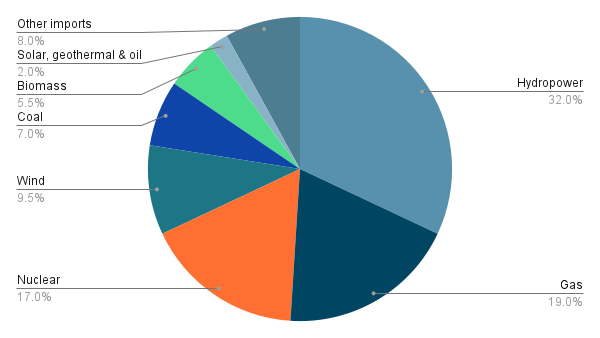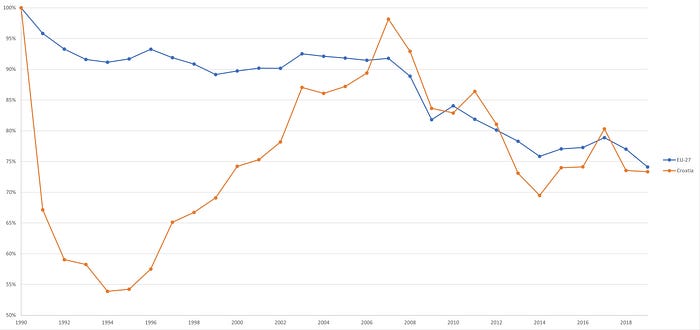The rise of global temperatures due to climate change is set to impact every ecosystem in the world. The United Nations Intergovernmental Panel on Climate Change and other researchers and publications assess that this decade is our last chance to avoid major environmental disasters. Every country in the world will have to find a way to if not prevent, at least restrain climate change. With energy generation being the biggest driver of CO2 emissions it is essential to transition to green energy and commit to a zero-carbon future as soon as possible.
Code Red for Humanity
The 2015 Paris Agreement was the first global treaty aimed at combating climate change. Over 190 countries agreed to limit the rise in global temperatures to below 2° Celsius compared to pre-industrial levels (while pursuing efforts to limit the increase to 1.5 degrees).¹
Looking back to the agreement in 2022, it is clear that the vast majority of countries failed to implement proper measures and legislation against climate change. The Intergovernmental Panel on Climate Change has published a report that paints a bleak picture and demands more ambitious climate action.²
The report focuses on the interconnections between climate, ecosystems and biodiversity. The change in global temperatures is not merely an abstract number — it needs to be viewed in context with many factors that influence climate change. Unsustainable consumption of natural resources causes ecosystem degradation which in turn causes biodiversity loss. These issues, while not a direct cause of climate change certainly amplify its consequences because forest biomes and vegetation, in particular, have a strong mitigating effect on the harmful consequences of climate change. The destruction of these ecosystems intensifies the warming effect of carbon dioxide in the atmosphere.
The goal of the Paris Agreement to limit the temperature rise to 1.5 degrees Celsius seems to have been both too challenging to achieve and at the same time not ambitious enough.
According to Berkeley Earth, our planet will reach a temperature rise of about 1.5°C by 2033.³
The report highlights that any additional warming above 1.5°C will result in an irreversible impact on ecosystems; particularly polar, mountain, and coastal areas.
Another less obvious consequence of climate change is the amplification of social and economic inequalities, especially between the developing Global South and the more developed countries in the Global North. Climate change is more destructive to countries close to the equator due to factors like underdeveloped infrastructure and the fact that these countries are already some of the warmest places on Earth. Even a small increase in temperature can cause more frequent droughts that, in turn, lead to crop failures and unprecedented famines. The IPCC’s report projects that droughts will displace as many as 700 million people in Africa, which will lead to the biggest humanitarian crisis ever.⁴ Moreover, rising sea levels caused by melting ice caps give rise to floods that are even more destructive to communities in developing countries.
The above-mentioned issues make it clear that climate change is a global problem and is not the responsibility of any singular nation; however, every nation has to do its part in reducing carbon emissions and mitigating the impact of resource consumption on the environment.
The Need for Green Energy
Electricity and heat production is the largest contributor to climate change, accounting for 25% of all global greenhouse gas emissions.⁵
Transitioning to green energy can have an enormous positive impact on keeping global temperatures down so it is important to have a concrete and comprehensive strategy for transforming the energy sector.
IPCC’s report has laid out the most needed and feasible measures necessary to reduce our vulnerabilities to climate change and to support the energy transition:
- Energy generation diversification (solar, wind, thermoelectric and hydroelectric)
- Improvements in energy efficiency
- Improving standards for energy networks (smart grids, more robust transmission systems)
A Concrete Strategy
In February of 2020, the Croatian parliament passed a much-needed National Energy Development Strategy for 2030.⁶ This article will cross-compare the state of the Croatian energy sector today, the 2030 goals, and how that fits with the ultimate goals of reducing adverse effects of climate change and carbon neutrality.
State of the Energy Sector in Croatia Now
Currently, Croatia imports 53.6% of its total electricity supply, which is a bit lower than the EU average of 57.5%.⁷ This number is somewhat skewed due to the fact that Croatia is a co-owner of the Krško nuclear plant in Slovenia which counts toward energy imports.
Hydropower accounts for almost a third of Croatia’s power supply, with natural gas being the second-largest source of electricity in Croatia (19%). The Krško nuclear power provides for 17% of Croatia’s energy needs. Wind makes up 9.5%, coal 7%, biomass 5.5%, and solar, geothermal and oil make up less than 1% each.⁸
While hydropower and wind make up over 40% of all electricity production, solar power is greatly underutilized. Croatia will most likely stop using coal by the end of the decade as Croatia’s only coal power plant, Plomin 2, which is located in Istria, operates on imported coal.

Renewable sources make up 53.8% of electricity sources in Croatia while the EU average is 37.5%.⁹ Globally, fossil fuels still make up the majority of electricity generation (63%), which is only a slight improvement from 50 years ago when more than three-quarters of the world’s electricity came from fossil fuels.¹⁰
On the bright side, the private sector is keen to invest in renewable energy in Croatia. There are numerous projects in development trying to utilize Croatia’s solar and wind potential:
- Wind energy companies Green Trust and Enercon are preparing to develop a €500 million wind farm¹¹
- Spanish renewable energy company Acciona is investing €200 million into solar and wind power plants¹²
- INA, the largest oil company in Croatia is investing in solar energy¹³
Looking Ahead
It is of no surprise that the transition to green energy will be capital intensive, so improved coordination between the Croatian government, European Union and the private sector is a requisite. The strategy’s goal is to completely transform energy production, consumption and distribution into a decentralized system that relies on low-carbon energy by the end of the decade.
Predicting a country’s energy needs decades into the future requires constant tracking of a country’s demographic factors, such as population, age composition, and migration trends. Modeling future energy usage across various sectors (households, construction, transport, etc.) is only possible by having an accurate idea of these demographic factors. Croatia has gone through negative demographic trends over the last three decades, and that is likely to continue. However, current and accurate demographic data is needed, and the real data is only measured once a decade through a population census.
Comparing current Croatian energy statistics to EU averages makes it clear that Croatia is doing remarkably well, but there is still much room for improvement:


The European Union’s emissions dropped by 4% after 1990 and didn’t drastically change until 2008. The 2008 economic crisis, as well as the introduction of stricter climate laws such as the 2020 climate & energy package, led to a steady decline in greenhouse gas emissions.¹⁶
Croatia, on the other hand, experienced war and rapid industrial decline following the Breakup of Yugoslavia in the 1990s, so greenhouse gas emissions plummeted. Emissions gradually rose from 1994 until 2008, when they started following the same trends as with the rest of the EU.
The National energy strategy has developed three scenarios that model the future of energy in Croatia:
- Scenario 0 → No change in energy policy
- Scenario 1 → Accelerated energy transition
- Scenario 2 → Moderate energy transition

Even looking at the best case scenario it is clear that the energy sector will only marginally change for the better. Considering the IPCC report stating that the Earth is on track to reach a 1.5°C temperature increase compared to pre-industrial levels by the early 2030s, it seems that the climate situation isn’t taken seriously in Croatia. However, while the intended changes to the energy sector don’t seem to make much of a difference in 2030, they are said to lay the legislative and regulatory groundwork for 2050.
The European Union aims to be climate-neutral by 2050, which is one of the main objectives of the European Green Deal, and Croatia is following the EU’s policies both short term and long term.¹⁷

Looking at the 2050 models, the situation looks much better; although it doesn’t quite live up to EU goals of zero emissions. These numbers should be analyzed with a bit more scrutiny than just taking them at face value. There are two obvious issues with these predictions. The first one is the fact that it’s easy to make plans 30 years in advance because the current people in the government most likely won’t be there to implement them, which is a much more difficult task. The second issue has to do with funding as this strategy doesn’t include any new government grants, subventions or tax reliefs. It relies mostly on a greater engagement from private companies, investment funds, and EU funds for modernization and innovations.
The road towards carbon neutrality will require unity and cohesion of governments, the private sector and the European Union, and that can’t be achieved without considerable efforts from every party.
The Key Decade
While carbon neutrality by 2050 seems like an ambitious goal, it is the most important project humanity as a whole has ever undertaken. There is a plethora of scientific evidence of climate change being a threat to both human and planetary well being, and therefore the energy transition has to be a unitary global action encompassing everyone from individuals, private corporations to multinational organizations.
Any further delay will result in irreversible consequences to every aspect of the environment and our way of life.
This decade is the last window of opportunity to curb climate change and stop it from leading to a 1.5°C or greater increase in global temperature.
Sadly, as the world’s energy needs are rising, so does the usage of fossil fuels. Contrary to all the buzz about green energy and sustainability, global fossil fuel consumption is on the rise, having doubled over the past 25 years.¹⁰
The likelihood of mitigating the negative consequences of climate change is impossible without decisive and comprehensive action. It is precisely for these reasons that we should aspire to carbon neutrality.
Author: Vedran Josipović
Sources
- Key aspects of the Paris Agreement, UNFCCC
- Climate Change 2022: Impacts, Adaptation and Vulnerability, IPCC
- Global Temperature Report for 2021 — Berkeley Earth, Berkeley Earth
- Latest IPCC Report Projects Drought Will Displace 700 Million in Africa — Climate Refugees, Climate Refugees
- Global Greenhouse Gas Emissions Data, EPA
- Croatian Energy Development Strategy for 2030, Narodne Novine
- Energy imports dependency, Eurostat
- The energy sector in Croatia, Bankwatch
- Share of energy from renewable sources, Eurostat
- Transformation — Key World Energy Statistics 2021, IEA
- Green Trust, Enercon unveil plan for 500 mln euro wind farm in Croatia, Renewables Now
- Acciona entering new investment round in Croatia, Balkan Green Energy News
- Oil company INA to install largest solar power plant in Croatia, Balkan Green Energy News
- Renewable energy as a % of gross energy consumption, Eurostat
- EEA greenhouse gases — data viewer, European Environment Agency
- 2020 climate & energy package, European Commission
- 2050 EU long-term strategy, European Commission







